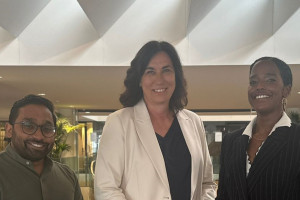Amsterdam is flat
Distinguished delegates to the United Nations International Student Conference in Amsterdam,
I hope you will have a successful conference in the comming week. I especially hope you are enjoying your time in Amsterdam.
As an alumni and former employee of the University of Amsterdam I was very pleased to be invited as speaker to the United Nations International Student Conference in Amsterdam. It is a unique opportunity to share some ideas on my city with you. As you have been trained into world class diplomats during the UNISCA conference I hope I can seduce you to act as ambassadors of Amsterdam in the future.
During your conference I assume you have talked a lot about how nations interact with each other. How can nations prevent disagreements to evolve into violent conflicts? How do nations come to agreements that go beyond their short term self interest, pursuing long term sustainable solutions to international problems.
It will not surprise you that my my talk is about the role of cities in the global political and economic system. I argue that in the current stage of globalization it has become imperative for cities like Amsterdam to behave as more active players on the world stage. In addition, I point out that human capital is becoming one of the most crucial factors in determining the competitiveness of a city like Amsterdam.
I think the student of international relations does not necessarily think of cities as major actors on the world stage.
Cities are usually not a party in trade agreements. Cities do not negotiate arms control deals or protocols on CO2 emission. But cities are one of the most important units that are confronted with the consequences of international politics.
Liberalization of global trade has produced shifts in production. When manufacturing jobs moved to low wage countries city governments were the first places that had to deal with growing unemployment. City governments had to adapt the physical and human infrastructure to attract the new economy jobs.
When international violent conflicts arise, cities are confronted with refugees. We are even confronted with international conflicts contributing to tension between different groups of citizens in Amsterdam.
Due to lack of international cooperation to contain crime and terrorism our citizens are confronted from time to time with increased levels of violence.
One can argue that these challenges have always existed. But due to the diminished capacity of national governments to shield its citizens from adverse international developments, cities have become more vulnerable.
While cities are not the most prominent actors on the world stage, one can argue that cities have become more important stake holders of the global system.
I mentioned already that the issues we face relating to the global system are not just economic, they are also political and social. In my speech today I will limit myself mostly to the economic aspects. This is because the economy the core part of my responsibilities as an alderman. I believe that a strong economy is a prerequisite to deal with various social problems and political tensions associated with globalization.
I was inspired by some of the ideas put forward in the book The World is Flat, by Thomas L. Friedman.
Friedman argues that at the turn of the century we have entered a new phase of globalization, globalization 3.0. In globalization 3.0 individuals rather than countries or multinational companies are the main actors. The widely spread availability of ICT technology has empowered individuals to compete on a global scale. Individual initiatives, individual creativity, individual ideas increasingly drive economic development. Software is replacing hardware as the key link to innovation and growth.
Three global developments have caused the so-called globalization 3.0, or the flat world.
First, the ICT revolution and the world wide availability of ICT technology link companies, communities and individuals world wide.
Second, liberalization of global and European trade and investment regimes allows for rapid shifts in production and trade of goods and services.
And third, the rise of newly industrializing nations, first by Japan and other East Asian countries and now, with a potentially much greater impact, China, India and Russia have truly globalized the world economy.
In flat world new technologies, new competitive forces come from every corner of the globe. 30 years ago, to know whether outside shocks to the Dutch economy could come, one only needed to watch the New York Stock Exchange and the German central bank. Now the previous European and American Champions are challenged by Indian and Chinese companies which have existed for about 20 years or less.
Financial problems of a bank in Thailand can cause regional crises that affect the whole global economy.
To illustrate the flat world,j ust look at two examples of Chinese companies located in Amsterdam.
In 1988 a former army officer in China started to distribute telecommunications technology with a few friends. Their first business deal was valued about 60 US Dollars. The company that he founded now has over 60.000 employees’ world wide and challenges companies such as Cisco Systems and Siemens in the global telecommunications equipment market.
This company is Huawei Technologies that employs already 160 people in Amsterdam.
In 1984, Mr Liu, a graduate from the Computing Technology Institute and founded a company with 25.000 US Dollar. In 2004, this same Mr. Liu bought the PC division of IBM for 1.25 billion US Dollars.
The City of Amsterdam has traditionally been in a good position to profit from transnational economic integration. Already in the 17th century, due to the influx of people from all over Europe, Amsterdam became the heart of a large international trading network, and a city where freedom, open minds and entrepreneurial spirit contributed to the creation of a centre of cultural, economic and technological innovation. Rembrandt’s paintings, the world’s first stock company and a revolution in ship building are some well known examples.
When economic interdependence became more manifest in the 1970s, decline in manufacturing hit other parts of the country more than it did Amsterdam.
Growing international trade benefited Amsterdam based traders, logistics and service providers. The fact that Amsterdam combines an international sea port with an airport naturally attracts companies that need to move people and goods.
The population of Amsterdam was on average already highly educated, creative, cosmopolitan and flexible.
This natural advantageous position was for some time taken for granted.
But in a flat world, we can no longer afford this attitude.
At the start of the 21st century it became clear that other European cities started to become more popular among investors, international talents, tourists etcetera. Cities, like Barcelona, Madrid Prague and Dublin had markedly improved there investment environment and had stepped up international promotion. Some cities were quick to discover the potential of the newly emerging markets and got a head start. Amsterdam’s position as a leading business centre in Europe was at stake. We had to make a choice between accepting this relative decline or formulating new ambitions and act on it.
In 2005 I proposed to opt for the second choice and to permanently bring Amsterdam back into the “Champions League”.
When I became alderman in 2006 I launched a new policy program called Amsterdam Top City to realize this goal.
We have refrained from to detailed and slow policy making and have started quite early with concrete projects, in cooperation with neighbouring cities, private companies, universities such as the UvA and other organizations.
There is a heavy emphasis on projects that develop the human capital of the city.
We are improving our service to expats, helping them to arrange all the paper work more efficiently and making sure sufficient housing is available.
Companies are actively supported and stimulated to work together on innovation, especially in sectors crucial in a flat world, like ICT, Bio-tech and creative industries.
We have increased our efforts to attract foreign companies to Amsterdam and we have developed a strategy for the international branding of Amsterdam. I am sure you have seen the I Amsterdam slogan somewhere. I Amsterdam suggest the identification of the individual with the creative, innovative and cosmopolitan city.
The University of Amsterdam in cooperation with the Free University will realize the Amsterdam University College that offers world class education. I like to think of this institution as Harvard along the Amstel River.
Using one example I want to illustrate how globalization has posed serious challenges for Amsterdam and how through successful cooperation between the government, the private sector and creative individuals the challenges of globalization can be successfully met.
If you cross the water behind the central station you reach the northern part of Amsterdam, on which the NDSM wharf is located. This used to be the world’s largest ship manufacturing wharf. Ship building activities had to end here in 1978 because of to much competition, especially from Japan. Hundreds of jobs were lost and the wharf lost all purpose until at the beginning of the new millennium, the local government, Dutch and foreign companies and local artists cooperated to invest again in this area. Now it is one of the hottest spots for creative industries and new media. Individual artists work a couple of hundred meters from the new MTV studio. The location attracts visitors and investors from all over the world.
On mainland Europe Amsterdam has a very strong position in advertising, new media and other creative industries. Neither the proletariat nor monopoly capital have emerged victorious from class struggle. In Amsterdam, it is the so-called creative class that has emerged from the technological revolution. In a flat world where individuals from anywhere compete and cooperate with each other, this so-called creative class plays a crucial role in maintaining the attractiveness of Amsterdam.
I now have to come to a conclusion on the thoughts I wanted to share with you. As an alderman of the city of Amsterdam I share a common interest with you in international affairs since open cities like Amsterdam are increasingly affected by global developments. Globalization has confronted cities with some challenges and opportunities. Amsterdam has been an internationally oriented city since the 17th century and has always adapted well to outside changes. However, in recent years, Amsterdam’s advantageous position came under pressure by newly rising competing centres of business. It has become imperative for Amsterdam to pursue much more active policies to compete on the world stage. Amsterdam has booked some initial success thanks to public-private cooperation and the focus on the development of human capital.
This is why I would also like to express my praise for the University of Amsterdam and all the participants of the Unisca conference for this great initiative. You certainly have made a significant contribution to developing the human capital Amsterdam needs.
I have mentioned the impact of global shifts on cities like Amsterdam. I think with your initiative Amsterdam can also have some impact on the rest of the world by training the next generation of diplomats. Surely a little bit more diplomacy is no luxury in the current world situation.
We still have a lot of work to do in Amsterdam. Not enough people are able to seize the opportunities that a flat world offers. We still do not always act quick enough to meet the challenges of a flat world.
I would like to invite you to contribute realizing Amsterdam’s ambitions. I am sure there are many employment opportunities in the city when you finish your studies.
If you find employment elsewhere I hope your experience in the city and at the UvA have converted you into ambassadors of Amsterdam in other parts of the world.
Thank you.



